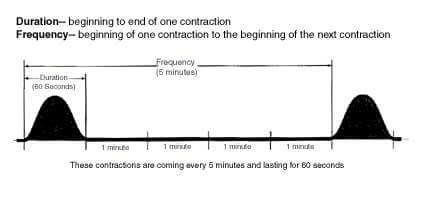How to Time Your Contractions
As you get close to your anticipated due date, you may start feeling uterine contractions. These practice contractions or false labor can begin as early as 30 to 34 weeks gestation. These practice contractions are usually irregular and vary in duration. Timing your contractions can help you and your physician decide if you are in labor or “just practicing”.
Timing your contractions is not difficult. You will need a pen or pencil, a piece of paper and a clock or watch with a second hand. When you first feel a contraction, write down the time it started. When the contraction ends write down the time it ended. When the next contraction starts write down the time it starts and stops. Continue this process for 30 to 60 minutes.
The definitions and diagram below illustrate this process.
- Contraction Frequency: the time from the start of one contraction to the start of the next contraction
- Contraction Duration: the length of time from the start of a contraction to the end of that contraction
- Contraction Regularity: the difference in the contraction pattern. Contractions are considered regular when each contraction is about the same duration or length and occur about the same time apart.

If you think you may be having contractions lie down or sit down with your feet up and time your contractions for at least 30 minutes. If you’re already laying down, get up and walk around and time the contractions. Remember, contractions before 37 weeks could signal premature labor, especially if five or more contractions occur in one hour. Do not wait! Let your physician know what is happening. Follow his or her instructions. Remember to stay hydrated.


